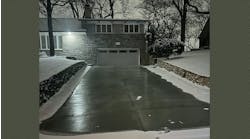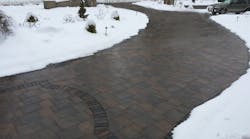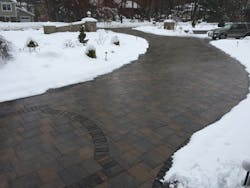His neighbors suspect he struck a deal with Old Man Winter. On mornings after a heavy snowfall as they labor away outside, Richard Burnett leisurely strolls down his perfectly dry, snow-free, stone paver driveway — cup of coffee in hand — to retrieve his newspaper.
He waves pleasantly. Neighbors return to shoveling, muttering unintelligibly.
“Scorn, envy and intrigue,” says Burnett. “I seem to get it all. Those who aren’t too shy to ask find that I’m a likeable guy, and I’ll gladly tell them all about it. That is — if they want to know."
Those neighbors who have asked soon learn that below the Burnetts’ floating stone paver surface is a network of snowmelt tubing, more than a mile in length. It’s ready to melt snow faster than they can lace up their snow boots.
Dramatic change
The Burnetts have lived in the neighborhood for more than 30 years. They raised five children who have now since grown, moved away and started families of their own. They now have five grandchildren — the light of their lives. The kids and grandkids visit frequently and often stay several days at a time.
Over the years, countless additions were added on to make room for the rapidly-growing family. In fact, the Burnetts’ remember when additions were made by which child was a baby at the time: “Oh, that was the Maria addition!”
The decision to make a dramatic change for comfort came in 2014, when the Burnetts decided to build a new home. Unwilling to part with the neighborhood, the roots and the good memories, they chose instead to knock down the existing 5,000-sq.ft. home.
Comfort control
Building a substantially larger French-style home with smart, energy efficient technology takes time. The home was under construction for two years, but the masterpiece is now complete.
The Burnetts chose to equip their new home with a sophisticated home control system.
“We’ve always wanted a home that was smart and efficient,” admits Burnett. “This was our chance to do it.” They chose a Crestron system to automate many facets of the home’s operations.
“The system is simple to operate for homeowners; it offers complete control of indoor and outdoor lighting, shades, HVAC, the home’s radiantly heated floors and the driveway snowmelt system,” explains Bill Barretta, president of Cresskill, New Jersey-based Barretta & Sons, Inc. — the plumbing and mechanical systems firm chosen by the Burnetts.
According to Burnett, their previous home’s hydronic baseboards “did the job,” but that’s where the line was drawn. Complete home comfort was unfamiliar territory until they moved into their new home.
Heated entirely by a hydronic radiant heat system, the home’s 17 zones — with 22,000 lineal feet of one-half-inch Watts RadiantPEX+ under the floors — provides a new level of comfort to Burnett for six or eight months of the year.
“The best part is — when our kids and grandkids are coming, we can activate those zones before they arrive, and off again after they leave,” explains Burnett. “I have 100 percent control of every part of the system right from my phone.”
The home automation system is linked to a tekmar 482 home automation interface gateway, so the Burnetts can monitor and enable/disable the radiant heat and snowmelt systems from anywhere at any time, just by accessing it on a smart phone.
Tropical warmth
Last winter the Burnetts went on a family vacation to Hawaii. Their house sitter called with news of an impending blizzard. Burnett was able to turn on the driveway snowmelt system from 6,000 miles away. When the storm swept in, the house sitter was there to verify that — yes indeed — the blizzard’s worst was no match for the gently-steaming driveway.
Yet, the temptation was too great. After the storm, the Burnetts used an iPad to access their security cameras and saw that the driveway was completely dry. “We were giddy,” says Burnett. “It was just the craziest experience to see the snow piled up all along the driveway, and yet the pavers were completely clear.”
Meanwhile . . . next door neighbors were toiling away, still at war against the 30-in. snowfall, followed by brisk winds. While snow drifts harassed their neighbors for days, the Burnetts relaxed under tropical sunshine.
From a beach-side cabana, they read, swam and occasionally took a peek at the iPad, amused at the sight of so much snow. “It was exactly where it was supposed to be,” says Burnett. “Not on the driveway and walkways.”
The Burnett’s 350-ft. stone paver driveway has three snowmelt zones: a parking area in front of the garages, a roundabout, and the area from there to the street. All contain a 40 percent glycol antifreeze mix.
“We used stone dust as a base below grade, just like any other paver driveway,” explains Richard Giacopelli, president of Bronx-based Mayrich Construction Corp., the excavating company appointed to the job.
“Above it, we used inch-and-a-half thick installation mats that the PEX snapped into, Giacopelli continued. “Another layer of stone dust on top of that made for a total of six inches of base before we finished with the stone pavers.”
In all, 10,800 lineal ft. of 5/8” Watts RadiantPEX+ make up the snowmelt system — just under 7,000-sq.ft. of total heated area. The radiant heat tubing receives heated water from three copper Watts Radiant manifolds. The manifolds distribute a water/glycol mix through 1½ x 5/8-inch tubing.
The home’s heating and snowmelt systems are served by two mechanical rooms. One is at west end of the home; the other at the east.
Each provides roughly half the heat needed for the snowmelt and heating zones closest to them.
On the west side, heat for the outdoor driveway and walkway surfaces is provided by two modulating-condensing boilers. Both are calibrated to send supply temps of 114°F into the snowmelt tubing.
Deep inside the Burnett home, a bank of Taco 007 circulators manages flow for the entire hydronic snowmelt system. Also an 80-gal. Bradford White indirect water heater receives heat routinely from the boilers to meet the family’s domestic hot water needs. The indirect is set for priority, but once its needs are met, the system is back in business to melt snow.
Tekmar sensors cut into the stone pavers monitor moisture and temperature, which assures that the system won’t kick on if it’s merely raining. If the sensors detect moisture, and temps below 34 degrees, the snowmelt system kicks on to achieve a surface temperature just above freezing — ideal to melt the snow and still be energy- and cost-efficient.
On the occasion of quick cold snaps — or a nuisance storm that stumps the weather experts with all of their sophisticated gear — the tekmar controls, paired with the home control system, give Burnett the ability to override the system, activating driveway heat in advance even when driveway sensors indicate no threat.
That’s exactly what happened when the Burnett’s house sitter called. “That I had this level of control from so far away — and while sipping a piña colada in a warm, tropical breeze — was the craziest feeling,” says Burnett. “My investment in the system was one I’ll be happy with for many years.”





